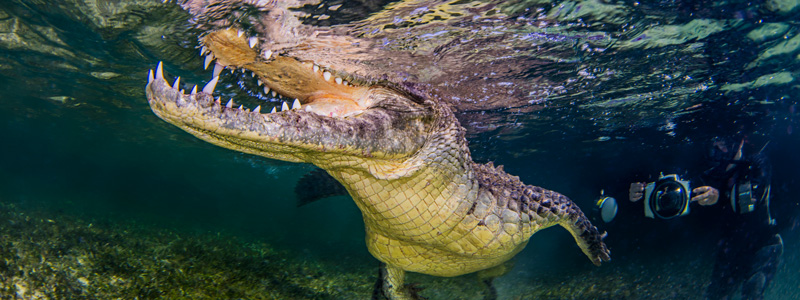Photographing Crocs: Behind the Scenes

About a year ago, I started seeing pictures of saltwater crocodiles pop up every once in a while on social media. And these pictures differed from the ones that I had seen in the past because they were from underwater. Immediately I had another item added to my ‘Bucket List’. The idea of being in the water with these toothy dinosaurs greatly appealed to me.
This adventure is a bit off the beaten path. Snorkeling safely with saltwater crocodiles begins with a flight to Cancun and a 6-hour bus ride to Xcalak, Mexico. Xcalak, which I still have problems pronouncing correctly, is a small-secluded town near the border with Belize. It is a wonderful relaxed area with beautiful beaches and almost virgin diving. Anything we did not need for the 3 days with the crocs stayed at our hotel Casa Carolina, which was a great convenience. We headed out early in the morning for Chinchorro Banks, with everything we needed for the 3-day adventure. The boat ride from Xcalak to Chinchorro is a bit of a 2-hour rodeo, with plenty of bucking bronco training on the chop a bonus. It’s definitely not a pleasure cruise J Once we arrived at the outer reefs though, I forgot all about the bus and boat ride! No boats in sight, and miles and miles of pristine coral reefs teeming with life!


About Chinchorro Banks and the Crocs
The Chinchorro Banks is a coral atoll, located about 30 miles from the Yucatan peninsula. There are no permanent settlements on the atoll, so we would be staying for the three days in a fisherman shack over the water. The Banks are designated a Biosphere Reserve, and permits are required to visit.
The crocodiles at Chinchorro are American Crocodiles (Crocodylus acutus). In the past, crocodile populations were hugely decreased due to over-exploitation, habitat destruction, and illegal hunting throughout Mexico. Luckily, the Mexican Government was very proactive once this population on the atoll was discovered, and has taken measures to ensure their protection. The approximately 400 crocodiles at Chinchorro are the most pure strain of American Crocodiles currently in existence, primarily because of their distance from the mainland and any real possibility of interspecies breeding. It is not known exactly how these crocodiles made their way to the atoll…

We had a small generator to charge batteries and brought everything else with us that we would need for the duration, including water, food, etc. Pack light for this portion, with only what you are going to need because space is at a premium.
Besides my first time swimming with crocodiles, I also had a first time experiencing a compost toilet. Gotta say… it’s better than a porta potty : )

Diving and Photographing the Crocs
 Each morning we would explore a new beautiful dive site on the reefs with scuba gear. Besides enjoying the unspoiled reefs on these dives, we helped protect the area by harvesting the invasive lionfish. After removing the poisonous barbs from the lionfish, we used their carcasses to keep the crocodiles interested in hanging out with us.
Each morning we would explore a new beautiful dive site on the reefs with scuba gear. Besides enjoying the unspoiled reefs on these dives, we helped protect the area by harvesting the invasive lionfish. After removing the poisonous barbs from the lionfish, we used their carcasses to keep the crocodiles interested in hanging out with us.
The guides from XTC wore many hats, and excelled at all of them. At times they were our cooks/dive guides/ safety divers/ luggage handlers and much more.
As the crocodiles were attracted and given some lionfish snacks, we observed each individual and paid close attention to their mannerisms and energy level. 2 divers and a safety diver were allowed in the water when the conditions were deemed safe to do so. The other guides kept watch at all times to make sure no crocodiles approached unseen. If the situation became questionable at any time, everyone was removed from the water until everything was under control.

The crocodiles are wild animals, and divers must utilize the knowledge from the experts and follow all rules that have been designed for safety. Staying focused on the crocodiles at all times is a must.
I would suggest being an experienced diver, preferably accustomed to being in the water with large animals before joining this type of expedition. Also, the more comfortable you are with your camera equipment and settings, the better. You will have to get out of the water any time you need to adjust your camera/strobes/equipment.


Tips for Photographing Crocodiles
Be patient and follow the guide’s instructions closely.
Move very slowly and carefully – the silt on the bottom is very fine and if disturbed, it can cloud the water easily.
Bring a wide-angle lens. The crocodiles range from 8 to 13 feet and will be close.
Pack lightly, but bring multiple batteries and memory cards.
Ken's Gear Profile
All images taken with Canon 5Ds or 5D Mark III in Ikelite housing with Canon 8-15mm fisheye and two Ikelite DS161 strobes.

Further Reading
RECOMMENDED ARTICLES
SUPPORT THE UNDERWATER PHOTOGRAPHY GUIDE:
The Best Service & Prices on u/w Photo Gear
 Visit Bluewater Photo & Video for all your underwater photography and video gear. Click, or call the team at (310) 633-5052 for expert advice!
Visit Bluewater Photo & Video for all your underwater photography and video gear. Click, or call the team at (310) 633-5052 for expert advice!
The Best Pricing, Service & Expert Advice to Book your Dive Trips
 Bluewater Travel is your full-service scuba travel agency. Let our expert advisers plan and book your next dive vacation. Run by divers, for divers.
Bluewater Travel is your full-service scuba travel agency. Let our expert advisers plan and book your next dive vacation. Run by divers, for divers.



































